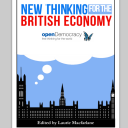Democratising pensions: where next after the USS strikes?

Image: Andy O’Donnell, CC BY-NC 2.0
The Universities Superannuation Scheme (USS) strikes are over – for now – after staff voted to accept a new offer from Universities UK. UUK has professed its commitment to maintaining a defined benefit (DB) scheme, and has agreed to reopen talks on the controversial scheme valuation. This is a victory for striking staff, and marks a significant shift from its belligerent insistence that DB was unaffordable. But the story is far from over: this is just a staging post on the way to finding a solution that meets the strikers’ concerns. As many have pointed out, it’s crucial that university staff don’t demobilise and that their supporters keep a watchful eye on proceedings.
As I’ve argued before, the USS strikes have shone a light on failings in our pension system which stretch far beyond our universities. I’m not going to rehearse these here (if you’re new to the world of pensions, it might be worth reading my previous piece for openDemocracy as a quick primer on how the system works at the moment). TL;DR: our pensions are highly financialised, highly privatised and highly marketized. The shunting of risk onto individuals which UCU members were fighting is already a reality for most of us. Unsurprisingly, this system is currently delivering pretty great outcomes for the City of London and pretty terrible outcomes for almost everyone else.
But this isn’t another piece about the problems with our pension system. This is about finding solutions. Whether we’re focussed on getting a good deal for USS members, on turning this dispute into the catalyst to demand bigger change, or on policy thinking for a radical government – it’s urgent that we start developing serious alternatives to business-as-usual. From public banking to municipal energy companies to community wealth building, there’s an exciting resurgence of new thinking on the economy which offers real alternatives to neoliberalism. But so far, pensions have been largely exempt from this. That needs to change, and fast.
I don’t pretend to have all the answers – there’s a dearth of creative thinking on this subject that will take time to fill, and I’d love to hear from people who are keen to work on it. But here’s a starter for ten, bringing together some of the best ideas I’ve come across – be they models we know work in other countries, or more radical ideas which fundamentally undercut the assumptions of today’s private pension systems, both here and abroad.
1. Stronger universal entitlements
The UK’s state pension is one of the least generous in the developed world – on some measures, the lowest in the OECD – yet is still the most important source of income for many households, especially those who can’t rely on a generous private pension. Historically, we’ve relied on employers acting out of their enlightened self-interest to provide employees with good pensions to plug this gap. This worked OK for a while, but in recent decades a toxic combination of growing workplace precarity and the explosion of financialisation has ripped the guts out of our workplace pension system. Auto-enrolment was designed to fix this mess, but has largely tried to do so with the same thinking that created it. We arguably need a more fundamental rethink, adjusting the balance between private saving and universal entitlements to something closer to that in, say, France and Germany.
Of course, raising the state pension is hugely expensive, particularly as the population ages. Strengthening universal entitlements through the existing state pension system would require significant tax raises. In this context it’s worth noting that tax relief on private pensions – which costs about £25bn a year – is widely acknowledged to be regressive, since it disproportionately benefits those who can afford to save a lot. Reforming pensions tax relief should definitely be on the table as part of a progressive fiscal policy – though it’s unlikely to be sufficient on its own.
Some argue that we need a more fundamental rethink of our approach to welfare. Pension systems are all about using the wealth generated by working people to support those who can no longer afford to work. But advocates of Universal Basic Income are questioning that logic at a deeper level, suggesting that it may not hold up in an age of increasing automation. UBI could in theory subsume the state pension – though it’s unclear whether it could be affordable at a level that would significantly improve on the current state of affairs (most models of UBI still have to be funded out of tax revenues).
But are there other ways we could fund universal entitlements (whether for pensioners or for everybody)? One promising idea is to create Social Wealth Funds, ideally capitalised using revenue generated by common resources – such as public land, the extraction of natural resources, or even intellectual property rights for advances which depend on publicly funded research. The Norwegian Oil Fund offers a precedent for using this approach to fund pensions (and also happens to be a global leader on socially responsible investment), while the Alaska Permanent Fund offers a precedent for a universal ‘citizen’s dividend’ (albeit at a much lower level).
2. Democratic, not-for-profit workplace pension provision
Of course, the USS dispute is about workplace pensions – and indicates a wider trend of employers increasingly wanting to offload their responsibility for pensions as deferred pay, and transition to ‘defined contribution’ (DC) arrangements which push risk onto the individual. For most of us, this is already a reality. Demanding a revival of genuine pension arrangements, which pool risk and share it more fairly, has to be a priority. There’s been a lot of interest lately in the Dutch model of ‘collective defined contribution’, a sort of half-way house between DB and DC. But I’d sound two notes of caution about this.
Firstly, without significant pressure from pension savers and social movements, this model is more likely to be used as a way to ‘level down’ existing DB provision than to ‘level up’ DC. As a way of creating counter-pressure on this, movements could demand that the government-backed NEST scheme be converted from DC to CDC, as Craig Berry has suggested. Secondly, CDC works in the context of a whole host of other features of the Dutch system – features it shares with other pension systems such as the Danish and Australian ones. Introduced as part of a wider package of reforms, it could help transform the UK landscape. Bolted on to our existing privatised and marketized model, it could simply serve to accelerate the erosion of what’s left of DB and create new opportunities for City capture.
So what are these features of other systems that the UK lacks? In essence, they involve a bigger role for large-scale, democratically owned and run, not-for-profit pension schemes which are directly accountable to their members – and a smaller role for shareholder-owned commercial insurance companies, which are fast becoming the norm in the UK. These schemes are generally organised at a sectoral level, and are tightly bound up with sectoral collective bargaining arrangements – for instance, trade unions play a key role in organising member voice within pension schemes. Emulating this model in the UK would therefore ideally need to be part of a wider shift in the economy and industrial relations, as many on the left are already advocating.
There’s good evidence that these models reduce opportunities for rent extraction by financial intermediaries and produce better outcomes for savers and society. In Australia, all workplace pensions must be run by a board of trustees, although not all must be non-profit. The Australian system as a whole appears to deliver better outcomes than the UK system, and within this, non-profit schemes (which combine a different business model with more equal representation for savers on their boards) appear to deliver better returns to savers than for-profit ones. The Dutch system produces vastly superior pension outcomes to the UK – a fact often attributed to the CDC model, but which can also plausibly be put down to its more democratic ownership and governance arrangements.
NEST is comparable to these schemes (although it is DC) – but its role in the new system of automatic enrolment was pared back from the original plans after insurance industry lobbying. Instead, many of our pensions will be nothing more than a contract between us and an insurance company. In the same way that we hand over our data to Facebook by ticking ‘I agree’, we become parties to contracts with our pension providers that we generally have no say over and no clue of the implications. Worse, unlike a trust-based pension scheme, the insurer has no strict legal duty to put our interests first (known as ‘fiduciary duties’) – indeed, it has a clearly conflicting legal duty to prioritise returns to its shareholders. This fiction of contractual consent, which enables abuse of power in broken markets, needs to be challenged in pensions just as much as it does in tech.
A recent Law Commission report concluded that “there are serious problems with the law relating to contract-based pensions, particularly in an auto-enrolment context” yet very little has been done. This is perhaps unsurprising: imposing strict fiduciary duties on insurance companies would completely trash their business models, probably requiring them to split their asset management arms from their pension provision, and perhaps even rendering the shareholder-owned model unsustainable. It would also be inconsistent with the idea of a contractual relationship between insurer and saver – even though this is little more than a legal fiction.
Yet this is precisely why the imposition of such duties is such a good, even necessary, idea. Contract-based pensions as currently designed are a dangerous racket that should have no place in a progressive pension system. If it is not possible to impose a more muscular legal and regulatory regime to protect savers, then they should be barred from providing auto-enrolment pension schemes altogether. In the UK context, this may sound radical – but as we’ve already seen, other countries have no qualms about specifying what kinds of institution are and are not fit to look after our pensions. By transitioning our workplace pension system to the kinds of democratic, not-for-profit model proven to work elsewhere, we would be leaving behind a disastrous neoliberal experiment and entering the mainstream.
Of course, as the USS debacle shows, these trust-based models are not a panacea. This recent analysis of the make-up of the USS board illustrates a wider problem: the people running our pensions tend to be selected for their investment expertise and are therefore deeply intertwined with the City establishment. They’re also barely accountable to the members they exist to serve. By contrast, evidence suggests that Dutch pension schemes have a culture of driving a harder bargain with asset managers – perhaps because trustee boards tend to be more representative of members’ interests and less dominated by City ‘experts’. Active steps therefore need to be taken to reverse the capture of our pension institutions by the City. Enhanced member representation and participation rights, as in the Danish system (along with better training), and an overhaul of senior personnel at the regulators, could be a good start.
It’s worth noting that this entire agenda will require huge amounts of political will and political capital, since the insurance and asset management industries will vigorously resist it. The current system is worth billions to them, and shifting from a marketized to a democratised workplace pension set-up would seriously hit both their power and their profits. They have kaiboshed much, much milder reforms in the past, and are very used to getting their way even at the cost of massive detriment to savers. Add to this the complexity of the pensions system, and the opportunities for regulatory capture this produces, and it’s clear that a radical incoming government will need a fully worked-through policy agenda on Day One – and a strong, well-informed movement behind it – if it’s to genuinely reset our pension system.
3. New ways of investing: looking under the bonnet
All the models we’ve discussed so far (apart from state pensions funded directly from taxation) still depend on the global financial markets to produce returns. In DB pension funds, the aim is to keep assets and liabilities balanced as money comes in through returns on accrued contributions and goes out through pension payments. In DC, the aim is simply to maximise the returns on the individual saver’s pot, which is then converted into an annuity (a financial product giving an annual income) at retirement. In Social Wealth Funds, the aim is to fund citizen entitlements out of the investment returns without eating into the principle (the underlying cash pile). Though the details differ, in all three cases, the returns are being generated through investing in tradeable financial assets such as equities and bonds. In this sense, all of these models are dependent on the financial markets – and thus on the decisions of investment managers.
Pensions policymakers tend to avoid looking ‘under the bonnet’ at the engine that actually generates the returns we rely on. If they did, it probably wouldn’t pass its MOT. Capital markets remain hopelessly short-termist and are a formidable machine for producing instability and inequality. We’re still much less good at managing the risks they produce than the City would like us to think. And, whether for economic or ecological reasons, there are genuine questions over whether they can keep delivering the levels of growth seen in the past. It’s therefore worth asking whether there are better ways of investing our common capital that are more democratic and less market-based.
The least radical (though not necessarily the easiest) approach would be to regulate capital markets for more long-term and sustainable investment. Suggestions I’ve seen include minimum holding periods for shares; financial transaction taxes to discourage speculative trading or ‘churning’ of portfolios; and banning or restricting ‘financial WMDs’, like certain kinds of derivatives. These approaches would be market-wide, but we could also rethink the regulations that apply specifically for pension funds, for instance by introducing caps on the level of portfolio churning, requirements to take climate change into account, or restricting particular ‘toxic’ investments, such as fossil fuels.
More fundamentally, we could seek new ways for pension funds to invest directly in socially useful activity. Pension funds could become sources of direct investment in public infrastructure, such as social housing or renewable energy generation, that delivers a stable long-term return. IFM, an investment manager owned by Australia’s not-for-profit pension funds, has pioneered ‘unlisted’ investments in infrastructure. In the US, the Capital Institute has proposed Evergreen Direct Investment, a model based on legal partnerships between individual companies and investors that sidestep the equity markets. In the UK, local authority pension funds in places like Strathclyde and Manchester have pioneered investments in local social housing and small businesses.
One proposal for scaling up this kind of activity is through state-sponsored national and local ‘economic renewal funds’, with pensions tax relief made conditional on pension funds contributing a certain minimum allocation to these funds. Another approach would be for pension funds to buy bonds which help capitalise a National Investment Bank (like the recently announced Scottish National Investment Bank), which would then lend in the pursuit of social and environmental missions. These approaches have the advantage of making it easier to preserve public ownership of public infrastructure – a risk when it comes to encouraging private pension funds to invest in infrastructure on their own behalfs, rather than via public or quasi-public institutions.
Towards a democratic future for pensions
There’s a huge amount of work still to be done, but I hope this sketch shows that there are real alternatives to our broken pension system. In fleshing these out into an agenda for change, we need to continually ask the basic questions about how we want our pension system to work. Where should the money come from to provide us with an income in old age? What kind of institutions do we want looking after this money, and who should they be accountable to? What is the economic model by which this money gets translated into a pension payout? And how do these payouts get shared out so as to fairly share the risks of old age?
Pensions can be hard to man the barricades for, but the USS strikes have shown it can be done. And it must be done. Our pension system touches on so many things that are central to the transformation we need in our economy and society. It’s about the future of welfare, how we provide for each other and how we pool risks and resources. It’s about our common capital, and whether we can imagine ways of owning, managing and investing it which don’t depend on markets and give us all an equal voice. It’s about taking on a financial elite which has its tentacles in far too many of our basic needs. If we want a democratic economy, we need to be fighting for more democratic pensions.






